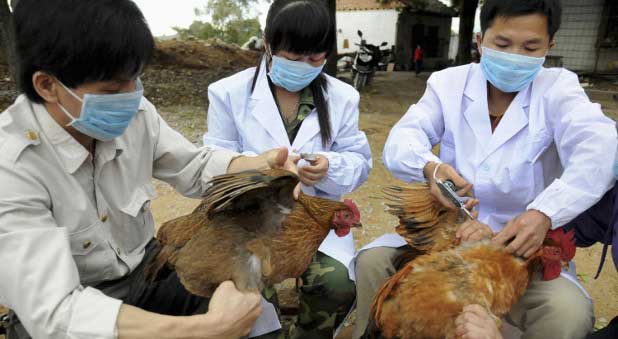Genetic sequence data on a deadly strain of bird flu previously unknown in people show the virus has already acquired some mutations that might make it more likely to cause a human pandemic, scientists say.
But there is no evidence so far that the H7N9 flu—now known to have infected nine people in China, killing three—is spreading from person to person, and there is still a chance it might peter out and never fully mutate into a human form of flu.
Just days after authorities in China announced they had identified cases of H7N9, flu experts in laboratories across the world are picking through the DNA sequence data of samples isolated from the patients to assess its pandemic potential.
One of the world’s top flu experts, Ab Osterhaus, who is based at the Erasmus Medical Center in The Netherlands, says the sequences show some genetic mutations that should put authorities on alert and entail increased surveillance in animals and humans.
“The virus has to a certain extent already adapted to mammalian species and to humans, so from that point of view it’s worrisome,” he told Reuters in a telephone interview.
“Really we should keep a very close eye on this.”
China’s National Health and Family Planning Commission confirmed on Sunday that three people had been infected with the new H7N9 flu, with two deaths of men in Shanghai aged 87 and 27 who fell sick in late February. Chinese authorities have in the past two days confirmed another six cases, including another fatal one.
The World Health Organization (WHO) says the cases of H7N9 are “of concern” because they are the first in humans.
“That makes it a unique event, which the World Health Organization is taking seriously,” the Geneva-based United Nations health agency said on Wednesday.
Other strains of bird flu, such as H5N1, have been circulating for many years and can be transmitted from bird to bird, and bird to human, but not from human to human.
So far, this lack of human-to-human transmission also appears to be a feature of the H7N9 strain.
Flu viruses are classified based on two types of protein found on their surface, hemagglutinin and neuraminidase, which are abbreviated to H and N.
Although it is very early days, scientists says initial analysis also suggests H7N9 does not appear to make birds particularly ill—in other words it is what is known as a low pathogenic avian influenza, of LPAI.
Unfortunately, this doesn’t necessarily mean it will be mild in humans, says Wendy Barclay, a flu virology expert at Britain’s Imperial College London.
Finding the Source
“We can’t be complacent. We have to be cautious,” she said, stressing that other H5 and H7 flu subtypes have been able to mutate from LPAI to the more dangerous highly pathogenic avian influenza (HPAI) as they circulate in various hosts, particularly in chickens.
Its mildness in birds could also mean H7N9 is a “silent spreader”—harder to detect than highly pathogenic flu strains such as H5N1 that can wipe out entire flocks of wild birds or domestic poultry and are therefore far more visible.
“It’s a sort of double-edged sword, because if and when it becomes highly pathogenic and all the chickens start dying, that’s very bad for the poultry farmers, but it means we can see much more easily where the virus is,” Barclay said.
“At the moment, we can’t see where this virus is coming from. We don’t know yet what animal source is feeding this.”
Finding that source, and tracking the genetic mutations to see if, how and when this new strain might gain the ability to spark a human pandemic are now the priorities for researchers in China and around the world, Barclay and Osterhaus said.
The WHO praised the Chinese government, saying it was responding to the situation with various important measures such as enhanced surveillance, detailed case management and treatment, tracing contacts of all those known to have been infected so far, and training healthcare professionals.
Experts said the fact that H7N9 had been identified and swiftly reported, and that genetic sequence data was already available for researchers around the world to analyze, was a sign of how things have changed.
In 2003, China initially tried to cover up an epidemic of Severe Acute Respiratory Syndrome, which emerged in China and killed about a tenth of the 8,000 people it infected worldwide.
Ian Jones, a professor of virology at Britain’s University of Reading, said the heightened awareness of flu and of the possibility that unusual respiratory diseases may turn out to be new strains of flu means more cases get referred to hospitals.
“It’s quite possible these cases … are being detected because flu is way up there” on disease priority lists, he said.
(Editing by Ben Hirschler and Will Waterman)
© 2013 Thomson Reuters. All rights reserved.











































